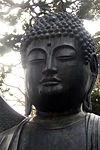Rochester Zen Center
| Rochester Zen Center | |
|---|---|
 | |
| Location | |
| Country | United States |
| Website | |
| http://www.rzc.org/ | |
| Part of a series on |
| Zen Buddhism |
|---|
 |
| Part of a series on |
| Western Buddhism |
|---|
 |
The Rochester Zen Center (RZC) is a Sōtō and Rinzai Zen Buddhist sangha in the Kapleau lineage, located in Rochester, New York and established in 1966 by Philip Kapleau. It is one of the oldest Zen centers in the United States.[citation needed]
History
This section contains promotional content. (November 2013) |
The history of the Rochester Zen Center begins with the Nuremberg and Tokyo War Crimes Trials at the close of World War II. Trying to come to grips with the appalling testimony he heard as a court reporter, thirty-three-year-old Philip Kapleau began a spiritual search that would lead him to a Japanese Zen Buddhist monastery in 1953. His experiences there became the basis of his classic book, The Three Pillars of Zen, still in print forty years after its initial publication. As of October 8, 2010, it was the ranked 7th in books on Zen Buddhism on Amazon.com.
One of the earliest readers of the book was a Batavia resident named Ralph Chapin, who saw the galley proofs while visiting Japan and asked that ten copies be sent him when the book was published. When they arrived, he passed one on to his Rochester friends Chester Carlson and his wife Dorris.[1][2][3][4] The Center's first sesshin took place in October, and the first issue of its newsletter, Zen Bow, appeared in 1967.
Since its founding, the Rochester Zen Center has become one of the largest Buddhist centers in North America.[5] From those first twenty-two individuals, membership has grown to more than six hundred, with sitting groups and affiliate centers in Mexico and Germany, and throughout the U.S.[citation needed] In 1981 Rochester Zen Center community split, when Toni Packer left the Center.
Through its daily meditation services, residential training programs, and introductory workshops, the Center has helped introduce Buddhism into the American mainstream, while simultaneously reshaping and integrating the forms of Zen into America's own unique culture.
The Rochester Zen Center has also contributed to the intellectual development of American Zen, through Philip Kapleau's books, The Zen of Living and Dying, Zen Merging of East and West, To Cherish All Life, and the recent Awakening to Zen and the writings of its members and its decennial anniversary conferences.[citation needed] In 1986, the 20th Anniversary Conference focused on "Buddhism and Nonviolence," and the 1996 Thirtieth Anniversary explored "Buddhism in America."
Since 1986 the head abbot at Rochester Zen Center has been Bodhin Kjolhede, who was sanctioned to teach by Kapleau.[6] The community offers intensive Zen sesshin retreats, introductory workshops and training programs throughout the year and is open to guests.[7]
Chapin Mill Buddhist Retreat
The Rochester Zen Center also has a 135-acre (0.55 km2) country retreat named Chapin Mill, donated by Ralph Chapin. Each year the center has several sesshin at Chapin Mill. The retreat center held a groundbreaking in April 2000. Building began in 2003, and was completed in 2007.
-
Dining hall facing kitchen.
-
Carved zendo door
-
Kannon Room
-
Facing enso, zendo on right carved door on left.
See also
References
- ^ "Rochester-area's Buddhists value meditative life". Democrat and Chronicle. Rochester, New York: Gannett. August 28, 2008.
In the days before the center, Fernandez was part of a small group of Buddhists who met and meditated at the home of Doris and Chester Carlson, the inventor of xerography. Few Rochesterians knew anything of Buddhism at the time, Fernandez says. 'I'd hear people refer to the center as the Zen medication center.' ¶ Carlson's fortune helped start the center, but he was not impressed with his wealth.
- ^ "Buddhist Masters and Their Organisations: Philip Kapleau Roshi". Buddha Dharma Education Association.
During Philip Kapleau's book tour in 1965 Dorris Carlson invited him to visit her small meditation group and in June 1966, with the support of the Carlsons, he founded the Rochester Zen Center.
- ^ "About Ralph Chapin". Rochester Zen Center. Rochester Zen Center.
Ralph obtained galleys of the book and was instrumental in introducing the book as well as Roshi Kapleau to Dorris and Chester Carlson, whose Rochester meditation group later formed the nucleus of the Rochester Zen Center.
- ^ "Roshi, Philip Kapleau #2". Zen Community of Oregon. Zen Community of Oregon.
Two of the earliest readers of Three Pillars were Ralph Chapin of Chapin Manufacturing in Batavia, New York, and Dorris Carlson of Rochester, New York, the wife of Chester Carlson, the inventor of xerography, the technology that became the foundation for the Xerox Corporation. During Philip Kapleau's book tour in 1965, Dorris Carlson invited him to visit her small meditation group and in June 1966, with the support of the Carlsons, he founded the Rochester Zen center.
- ^ Farrier-Halls, 150
- ^ Kraft, 190
- ^ Ford, 759
Sources
- Farrer-Halls, Gill (2000). The Illustrated Encyclopedia of Buddhist Wisdom. Quest Books. p. 150. ISBN 978-0-8356-0786-5.
- Ryūken Williams, Duncan; Christopher S. Queen (1998). American Buddhism: Methods and Findings in Recent Scholarship. RoutledgeCurzon. p. 93. ISBN 978-0-7007-1081-2.
- Ford, James Ishmael (2006). Zen Master Who?: A Guide to the People and Stories of Zen. Wisdom Publications. p. 759. ISBN 0-86171-509-8.
- Kraft, Kenneth (1998). Zen, Tradition and Transition. Grove Press. p. 190. ISBN 978-0-8021-3162-1.
External links
![]() Media related to Rochester Zen Center at Wikimedia Commons
Media related to Rochester Zen Center at Wikimedia Commons









